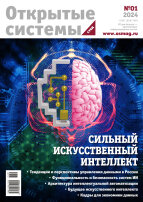_250.jpg) COVER FEATURES
COVER FEATURES
DIGITAL TRANSFORMATION
Digital Transformation in Numbers
Increasingly, digital transformation is mentioned as a key to successful business development, yet up to now neither there is a clear understanding of the concept, nor there are agreed quantitative measurements to assess a digital transformation. In addition, the concept itself has no definitive boundaries.
Alexander Prokhorov (prokhorov.alexander@huawei.com), manager, Huawei (Moscow).
Storage Architecture for Digital Enterprise
The growth of data along with an increasing demand for its availability, aggregation and use create the need for low-cost high-capacity storage systems having virtually unlimited scalability. Traditional architectures do not satisfy those demands.
Vasily Kostryukov (vasilyk@infinidat.com), staff member, Infinidat (Moscow).
Smart Resources Protection for Digital Business
Born at the confluence of physical and virtual worlds, digital enterprise changes business processes and models inevitably increasing information security risks. As a result, new types of large-scale attacks emerge that render useless counter measures pre-programmed to fight off certain attack kinds.
Alexey Semenyaka (as@qrator.net), executive director, Qrator Labs (Moscow).
Agile and DevOps in the Service of Large Businesses
Cloud computing, big data, and the Internet of Things can afford competitive advantage to a digital enterprise, yet traditional IT cannot support new business models, as well as timely development of new services and applications, or modification of existing ones.
Andrey Kosygin (andrey.kosygin@hpe.com), lead solution architect, Hewlett-Packard Enterprise Russia.
PLATFORMS
Adapting to Thrive in a New Economy of Memory Abundance
Processing technology has eclipsed memory technology for the past six decades, but processor-centric architectures are reaching their terminal efficiency. We can reboot computing on the basis of abundant memory enabled by emerging device physics, which will make computation, communication, and memory more efficient. This approach also provides a unique opportunity to address novel security threats with modern, systemic solutions.
Kirk M. Bresniker, Sharad Singhal, and R. Stanley Williams (kirk.bresniker, sharad.singhal, stan.williams@hpe.com), staff members, HP Labs.
IT MANAGEMENT
Automated Business Process Structure Discovery
IT architects are faced with the challenge of complexity in the design of enterprise-wide IT systems. Complexity can be reduced by dividing a system into several subsystems. The paper proposes an approach to separate business processes into groups, in which members are closely linked but the process groups as a whole are loosely coupled. Architects can also use the approach as a tool for business processes and requirements analysis as well as functions, IT systems, subsystems or services design using the SOA notation.
Evgeniy Smirnykh (e_smirnykh@rn-inform.ru), senior architect, RN-Inform (Rosneft subsidiary).
INTEGRATION
A Tool to Jump-Start Startups
Today, startups don’t have to have enormous capital to implement their ideas, yet they consistently need tools helping to show off their vision to market and convince investors. Existing application integration tools like InterSystems Ensemble have proved to be quite useful for the task.
Tamara Lebedeva (tlebedeva@systems.moscow), architect, Black Mushroom (Moscow).
EXPERIENCE
Cluster Analysis of Anomalies in Telecommunication Networks
Troubles in telecommunication networks often arise from anomalies that do not cause disturbances and are left unnoticed, which can lead to degrading quality of service or faults. Detecting such anomalies using cluster analysis enables to take proactive measures helping to prevent failures.
Andrey Yegorov (ay@bekitzur.com), lead engineer, BeKitzur; Alexander Smirnov (Alexandr.Smirnov@motorolasolutions.com), lead engineer, Motorola Solutions (St. Petersburg).
EXTREME TECHNOLOGY
The Future of Solid State Memory
Flash memory is not a silver bullet, rather just the first attempt at replacing hard disk drives. The development of solid state non-volatile memory will go along the lines set by the NVM Express protocol.
Leonid Chernyak (lc1244@gmail.com), freelance writer, (Moscow).
THE WORLD
The Power of Community
What is the real objective of achieving technological independence, and what needs to be done for it?
Dmitry Volkov (vlk@osp.ru), editor-in-chief, Open Systems Journal.DBMS.
Five Years of Using Kotlin
Rather than focusing on producing «domestic» products, software developers today need to create high-quality, in-demand applications using highly-efficient tools. The Kotlin programming language enables to write compact code that is easy to read and maintain while the supporting toolset increases productivity and automates routine tasks.
Dmitry Volkov (vlk@osp.ru), editor-in-chief, Open Systems Journal.DBMS.
IT UNIVERSITIES
IT Systems Through the Looking Glass of Academic Papers
A quantitative analysis of scientific papers allows to determine current research trends in individual areas. A scientometrics evaluation of corporate IT systems was no exception: it has helped to get an idea of the current state of things in the field.
Yuri Zelenkov (yuri.zelenkov@gmail.com), applied informatics department chair, Financial University under the Government of the Russian Federation.
LIBRARY
Electronic Surveillance and Big Data
The March and April issues of the Computer magazine (IEEE Computer Society, Vol. 49, No. 3, 4, 2016) focus on the state of the art in electronic surveillance and big data technologies.
Alexander Tyrenko (shoorah@osp.ru), reviewer, Computerworld Russia.
